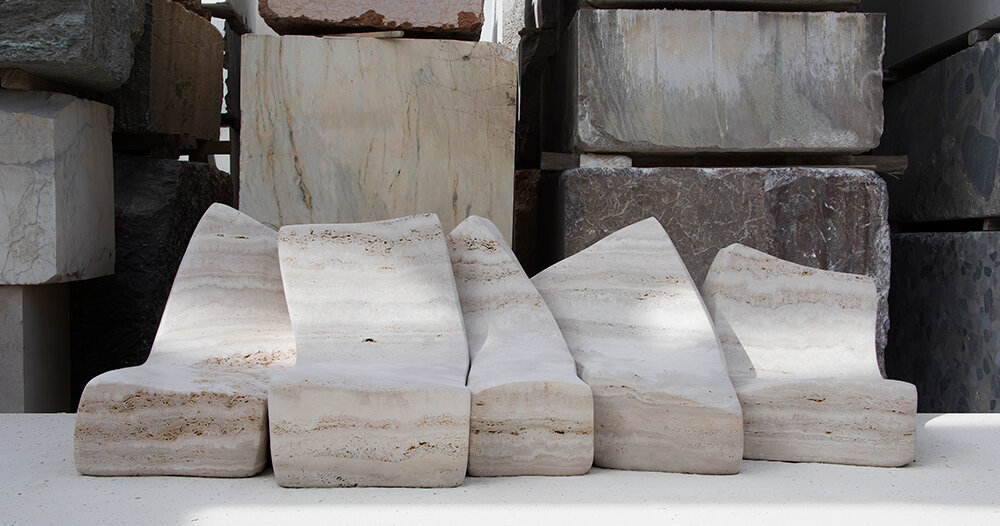the lebanese artist returns to friedman benda NYC
Friedman Benda‘s New York gallery opens Opacity, transparency, and everything in between, the second solo show of Lebanese designer Najla El Zein. This collection centers on layers of perception and understanding, bridging the tangible and intangible through innovative use of stone, glass, and ceramic. El Zein underscores the essence of her work: ‘The show reflects on one’s initial perceptions, misunderstandings, and the necessity to decipher the layers beneath, as truth often lies between the lines.’ While she is most familiar with stone, this thematic exploration led her to experiment with new materials — glass and ceramic — each lending new discoveries through their unique qualities.
 Group of Five, Najla El Zein | image © Diana Merhez, courtesy of Friedman Benda, Najla El Zein
Group of Five, Najla El Zein | image © Diana Merhez, courtesy of Friedman Benda, Najla El Zein
interview with najla el zein
designboom interviewed artist Najla El Zein at Friedman Benda‘s opening of Opacity, transparency, and everything in between, where she shared her motivations through this new body of work: ‘The show resists the boundaries of what you see, what you don’t see, what you understand, what you don’t understand. What I’m really interested in is the space in-between these two realities, which is so complex, so rich, and so beautiful.’ This fascination guided her selection of stone, glass, and ceramic, materials that echo the Earth’s natural processes and transformations.

Group of Five | image © Diana Merhez, courtesy of Friedman Benda, Najla El Zein
One of the standout pieces, ‘Group of Five,’ exemplifies El Zein’s exploration of group dynamics. She described the piece: ‘It explores the notion of group dynamics. I wanted to create a piece that would be gradually discovered. At first you see it as a cohesive group of distinct personalities that are interacting with another. Then when you turn around it, you start discovering new curvatures, new movements.’ This method of engagement invites viewers to continuously uncover new aspects of the work, mirroring the complexities of human relationships.

Family of Three | image © Damien Arlettaz, courtesy of Friedman Benda, Najla El Zein
While Najla El Zein notes that her venture into glasswork was challenging, it led to important discoveries about both the material and the collaborative process, which she discussed at Friedman Benda: ‘In the beginning, because I was coming from the world of stone, I wanted to control every single aspect of the glass and what I wanted it to become,‘ she explained. ‘The first hot shop was a disaster… But as persistent as I am, I kept going back, and every time with new models.’ This perseverance paid off when she and her team reached a level of intuitive understanding, resulting in the creation of the ‘Ensemble’ series. ‘The name of the works, Ensemble, comes from the musical connotation, because it’s really about that. It’s about the performance and orchestra, a choreography, a connection between each glassblower.’

Lover’s Bench | image © Damien Arlettaz, courtesy of Friedman Benda, Najla El Zein
Ceramic presented a different set of challenges and surprises. El Zein recounted her experience: ‘I began to work with ceramic, which is a material of mystery and chance. You cannot control ceramic, and that was accepted from the beginning.’ The large-scale piece Family of Three required thoughtful construction and an acceptance of the material’s unpredictability. ‘The result was something completely different, because the glaze continued moving in the kiln. I was amazed by that, and it was such an incredible surprise. It reminds me of bones. The seams even look like articulations.’

Ensemble no.06 | image © Frans Parthesius, courtesy of Friedman Benda, Najla El Zein
At Friedman Benda, Opacity, transparency, and everything in between shows Najla El Zein’s relentless pursuit of understanding. Her work invites viewers to discover the layers of perception and human connection. As she puts it, ‘My objective with this series of works is to convey such understanding and nuances through the dimensions of time, space, materiality, light, reflection, use, touch, and emotions, hoping to discover answers and provoke new questions.’ While the show is a display of art, it is also an exploration of life’s intricacies, captured through the transformations of stone, glass, and ceramic.
